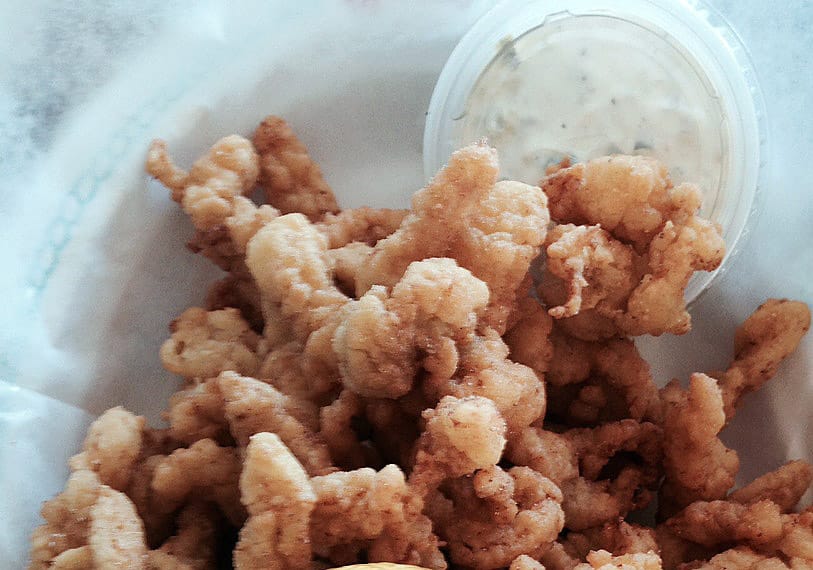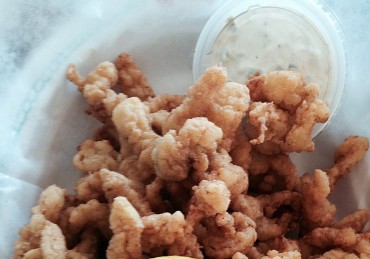History
OK, So Who Was the First to Fry a Clam? | Jud’s New England Journal
Okay, So Who Was the First to Fry a Clam? I feel pretty certain as to who was the first to EAT a clam. But as to frying one, well, there seems to be a difference of opinion… We can be proud of those among our New England ancestors who first ate or first cooked […]

Okay, So Who Was the First to Fry a Clam?
I feel pretty certain as to who was the first to EAT a clam. But as to frying one, well, there seems to be a difference of opinion…
We can be proud of those among our New England ancestors who first ate or first cooked certain foods. For instance, I enjoy occasionally mentioning that the hamburger was invented at a place called Louis’ Lunch in New Haven, Connecticut.
And I think everyone knows that the “grinder” was first made in New London, Connecticut. Of course, it went on to become a “poor boy” or a “garibaldi” or a “zeppelin” or a “torpedo” or a “rocker” or a “bomber” or a “submarine” or a “hoagie” and so on, depending on the location across America. But to me a grinder is a grinder by whatever name. Its originator was Benedetto (Benny) Capalbo, who for years operated a grocery store in the heart of New London’s Italian section.
A prehistoric Indian was surely the first to enjoy the sweet nectar oozing from maple trees in March, but the consensus is that Samuel Cunnabell of Bernardston, Massachusetts, was the first white man to “gather sap in a basket and boil it in a tub.” Likewise, I’m sure the Indians found clams to be pretty tasty. However, most feel it was Ruth Alden Bass of Duxbury, Massachusetts, noticing her pigs eating clams along the shore, who was the first white settler to actually eat a clam. So began clams on the half shell, clam fritters, clam pie, clam chowder, littleneck clams — well, the list could continue for pages. So it was that Ruth Alden Bass had taken one giant gulp for mankind. (Sorry …)
So, okay, having given Ms. Bass her due, who was the first to fry a clam?
Most people credit Lawrence H. Woodman, who operated a small concession stand in Essex, Massachusetts. On the reverse side of Lawrence and Bessie Woodman’s wedding certificate are written the birth dates of their two oldest sons, Wilbur and Henry, and, directly under these dates, “We fried the first fried clam — in the town of Essex, July 3, 1916.” I know this because I researched an article for Yankee about it some years ago. What surprised me most was the amount of mail we received after its publication. Readers didn’t doubt the Woodmans’ fried clam on July 3, 1916. Rather they all claimed earlier fryings. As I recall, the very earliest was fried by a Hosea B. Quint, who ran a fish market in West Lynn, Massachusetts, and fried clams for his customers every Friday as early as 1910.
I’ve since read in Richard J. Hooker’s book, Food and Drink in America, however, that a Dr. Alexander Hamilton fried and ate some clams at the Narrows ferry landing on Staten Island in 1744! (Let’s just hope the New Yorkers don’t get wind of this.)
Surely, however, everyone can agree on a certain scientific law that holds true in all cases. To wit: “The flavor of a fried clam is in inverse proportion to the square of the distance from the ocean to the place where it’s fried.”
Now … can anyone tell me what brave person was the first to swallow an oyster?
feel pretty certain as to who was the first to EAT a clam. But as to frying one, well, there seems to be a difference of opinion…
We can be proud of those among our New England ancestors who first ate or first cooked certain foods. For instance, I enjoy occasionally mentioning that the hamburger was invented at a place called Louis’ Lunch in New Haven, Connecticut.
And I think everyone knows that the “grinder” was first made in New London, Connecticut. Of course, it went on to become a “poor boy” or a “garibaldi” or a “zeppelin” or a “torpedo” or a “rocker” or a “bomber” or a “submarine” or a “hoagie” and so on, depending on the location across America. But to me a grinder is a grinder by whatever name. Its originator was Benedetto (Benny) Capalbo, who for years operated a grocery store in the heart of New London’s Italian section.
A prehistoric Indian was surely the first to enjoy the sweet nectar oozing from maple trees in March, but the consensus is that Samuel Cunnabell of Bernardston, Massachusetts, was the first white man to “gather sap in a basket and boil it in a tub.” Likewise, I’m sure the Indians found clams to be pretty tasty. However, most feel it was Ruth Alden Bass of Duxbury, Massachusetts, noticing her pigs eating clams along the shore, who was the first white settler to actually eat a clam. So began clams on the half shell, clam fritters, clam pie, clam chowder, littleneck clams — well, the list could continue for pages. So it was that Ruth Alden Bass had taken one giant gulp for mankind. (Sorry …)
So, okay, having given Ms. Bass her due, who was the first to fry a clam?
Most people credit Lawrence H. Woodman, who operated a small concession stand in Essex, Massachusetts. On the reverse side of Lawrence and Bessie Woodman’s wedding certificate are written the birth dates of their two oldest sons, Wilbur and Henry, and, directly under these dates, “We fried the first fried clam — in the town of Essex, July 3, 1916.” I know this because I researched an article for Yankee about it some years ago. What surprised me most was the amount of mail we received after its publication. Readers didn’t doubt the Woodmans’ fried clam on July 3, 1916. Rather they all claimed earlier fryings. As I recall, the very earliest was fried by a Hosea B. Quint, who ran a fish market in West Lynn, Massachusetts, and fried clams for his customers every Friday as early as 1910.
I’ve since read in Richard J. Hooker’s book, Food and Drink in America, however, that a Dr. Alexander Hamilton fried and ate some clams at the Narrows ferry landing on Staten Island in 1744! (Let’s just hope the New Yorkers don’t get wind of this.)
Surely, however, everyone can agree on a certain scientific law that holds true in all cases. To wit: “The flavor of a fried clam is in inverse proportion to the square of the distance from the ocean to the place where it’s fried.”
Now … can anyone tell me what brave person was the first to swallow an oyster?

